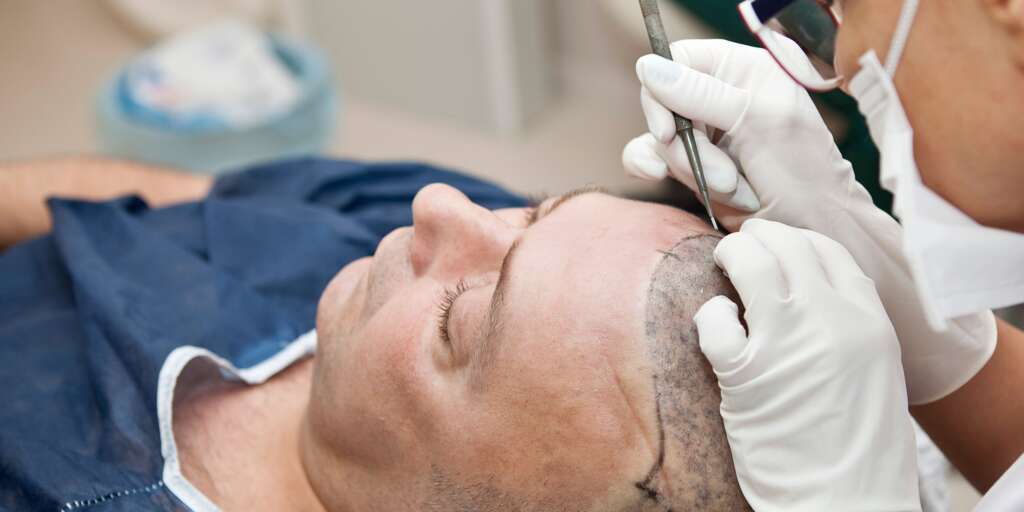It’s normal to lose approximately 50 to 100 hairs per day. But, when it fails to regrow, that means your follicles have thinned and intervention may be necessary. Hair loss can affect anyone at any age. If it’s a problem for you, the best hair transplant surgeon in Towson, Maryland can help.
If you’re planning to schedule an appointment, read this first. It’s a detailed Q&A that will help you prepare for a hair loss consultation and provide answers about the procedure.
What Causes Hair Loss?
There is no evidence linking male or female pattern baldness to factors like tight scalp muscles, stress, shampoo, or skin issues. Hair loss can stem from various factors. For example, genetics, hormonal changes, medical conditions such as alopecia areata or thyroid issues, and certain medications.
Poor diet, stress, and hairstyles can exert excessive tension on hair. Your surgeon will work with you to identify the underlying cause for effective treatment.
What can I expect During Hair Transplant?
The primary methods are the strip method or follicular unit transplantation (FUT) and follicular unit extraction (FUE).
FUT involves removing a scalp strip from the donor area and dividing it into individual hair grafts. The donor area is then sutured, leaving a concealed linear scar. These grafts are meticulously transplanted into areas with hair loss.
FUE is a less invasive method. Using punch tools or robotic assistance, individual hair follicles are directly extracted from the donor area. Extracted follicles are subsequently transplanted into areas requiring hair. Many surgeons prefer NeoGraft for follicular unit extraction because it avoids a linear incision, resulting in less noticeable dot-like scars.
Both methods have advantages and considerations such as hair loss extent, donor area traits, personal preferences, costs, and expertise.
Does a Hair Transplant Hurt?
Of course, pain levels vary from person to person, but the best hair transplant surgeon in Towson, Maryland cares about your comfort. In order to numb the surgical site, a local anesthetic is given. This might cause mild discomfort initially, but it fades rather quickly.
To ensure you are relaxed during the procedure, you may also be given pain relievers or sedatives. There is no reason to worry because your options will be discussed in advance.
What Are the Risks of Hair Restoration Surgery?
All surgical procedures carry risks, but complications from hair loss treatment are usually minor. Bleeding or infection happens, though rarely. You can significantly decrease the chance of complications by following your surgeon’s pre-op and post-hair transplant instructions carefully.
What Happens During Hair Transplant Recovery?
Patience is key. Allow yourself time to properly heal, and don’t try to rush your recovery. Doing so may interfere with your desired outcome.
The majority of patients can resume work within 24 to 48 hours following their hair restoration procedure. However, you should restrict strenuous physical activity for about five to seven days.
To reduce potential swelling, medication is administered. Temporary crusting or scabs might be present for seven to ten days, accompanied by mild itching. Don’t pick scabs. Instead, let them fall off naturally.
Numbness at the donor or recipient sites usually dissipates within several weeks to a few months. Follow-up visits are typically scheduled at four to six-month intervals. This is necessary to monitor progress and evaluate results.
Here is the average hair growth rate after a transplant:
- 3 months: 10% hair growth
- 4 to 5 months: 20% to 30% hair growth
- 6 to 7 months: 40% to 50% hair growth
- 8 to 9 months: 60% to 80% hair growth
- 10 to 12 months: 80% to 90% hair growth
Are Results From a Hair Transplant Permanent?
Many patients panic a bit when they see shedding a few weeks following their procedure. Rest assured, this is completely normal and the transplanted area will see new hair growth. Due to the nature of harvested follicles, it isn’t likely you’ll resume a pattern of baldness at the surgical site.
Unfortunately, a hair transplant can’t stop the aging process. This means thinning can occur in non-treated areas. Therefore, it may be necessary to repeat the procedures at a later date.
How Can I Find Out if I Qualify for a Hair Transplant?
The easiest way to find out is during a consultation with a qualified and experienced hair transplant surgeon.
Hair restoration is not usually limited by age or gender. In fact, patients aged 70 and older have received successful hair transplants. Also, hair transplants can effectively treat individuals in their 30s with male or female pattern baldness. In fact, even younger patients may be considered with a more conservative approach.
During your first consultation, the surgeon will assess your hair growth and loss, delve into your family’s history of hair loss, and inquire about any past hair transplant procedures. Be prepared to answer questions about lifestyle, expectations, and goals.
Hair restoration surgery may be ideal for you if you have healthy hair on the sides and back of your head. These areas serve as donor areas for grafts. If you have well-defined baldness, thinning hair, limited hair loss from scalp injuries, or repeated cosmetic procedures you might also be a great candidate for a hair transplant.
You’ll Find the Best Hair Transplant Surgeon in Towson, Maryland at Kindred Hair & Skin Center!
For top-notch expertise and professionalism, it’s time to book a consultation with Dr. Chesahna Kindred. Dr. Kindred has devoted her career to ensuring remarkable hair transplant success rates.
Contact us at 443-424-7754 to schedule your appointment, and let’s take the first step down your path to a beautiful, healthy head of hair!

